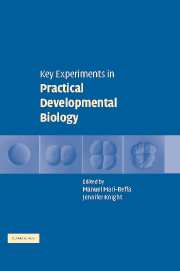Book contents
- Frontmatter
- Contents
- List of contributors
- Preface
- Introduction
- SECTION I GRAFTINGS
- 1 Two developmental gradients control head formation in hydra
- 2 Embryonic regulation and induction in sea urchin development
- 3 The isthmic organizer and brain regionalization in chick embryos
- SECTION II SPECIFIC CHEMICAL REAGENTS
- SECTION III BEAD IMPLANTATION
- SECTION IV NUCLEIC ACID INJECTIONS
- SECTION V GENETIC ANALYSIS
- SECTION VI CLONAL ANALYSIS
- SECTION VII IN SITU HYBRIDIZATION
- SECTION VIII TRANSGENIC ORGANISMS
- SECTION IX VERTEBRATE CLONING
- SECTION X CELL CULTURE
- SECTION XI EVO–DEVO STUDIES
- SECTION XII COMPUTATIONAL MODELLING
- Appendix 1 Abbreviations
- Appendix 2 Suppliers
- Index
- Plate Section
- References
2 - Embryonic regulation and induction in sea urchin development
Published online by Cambridge University Press: 11 August 2009
- Frontmatter
- Contents
- List of contributors
- Preface
- Introduction
- SECTION I GRAFTINGS
- 1 Two developmental gradients control head formation in hydra
- 2 Embryonic regulation and induction in sea urchin development
- 3 The isthmic organizer and brain regionalization in chick embryos
- SECTION II SPECIFIC CHEMICAL REAGENTS
- SECTION III BEAD IMPLANTATION
- SECTION IV NUCLEIC ACID INJECTIONS
- SECTION V GENETIC ANALYSIS
- SECTION VI CLONAL ANALYSIS
- SECTION VII IN SITU HYBRIDIZATION
- SECTION VIII TRANSGENIC ORGANISMS
- SECTION IX VERTEBRATE CLONING
- SECTION X CELL CULTURE
- SECTION XI EVO–DEVO STUDIES
- SECTION XII COMPUTATIONAL MODELLING
- Appendix 1 Abbreviations
- Appendix 2 Suppliers
- Index
- Plate Section
- References
Summary
OBJECTIVE OF THE EXPERIMENT Cell–cell interactions play an important role in the early patterning of animal embryos. Polarity inherent in the oocyte or established soon after fertilization entrains subsequent cell signaling events that subdivide the early embryo into distinct territories of gene expression and cell fate.
The objective of the experiments described in this chapter is to illustrate the role of cell–cell signaling in patterning early animal embryos. The sea urchin, a deuterostome that relies extensively on cell interactions to specify blastomere fates, is used as a model system. Two major experiments are described: (1) Analysis of the development of individual blastomeres isolated from early cleavage stage embryos, illustrating the phenomenon of regulative development. (2) Recombination of micromeres with animal blastomeres, illustrating the process of embryonic induction. In addition, a third experiment is described that involves the use of molecular markers (antibodies) to analyze cell fates, an approach that can be applied to either of the first two experiments.
DEGREE OF DIFFICULTY Experiment 1 requires students to collect sea urchin gametes, fertilize eggs, and dissociate embryos. All these skills can be learned relatively easily. Experiment 2 is moderately difficult as it involves micromanipulation, a technique that demands dexterity and patience. Both experiments require stereomicroscopes. The results of Experiments 1 and 2 can be assessed morphologically or by staining embryo whole mounts with antibodies that label specific tissue types (Experiment 3). The latter approach is technically straightforward but requires a compound microscope, preferably one equipped for epifluorescence.
- Type
- Chapter
- Information
- Key Experiments in Practical Developmental Biology , pp. 23 - 36Publisher: Cambridge University PressPrint publication year: 2005



